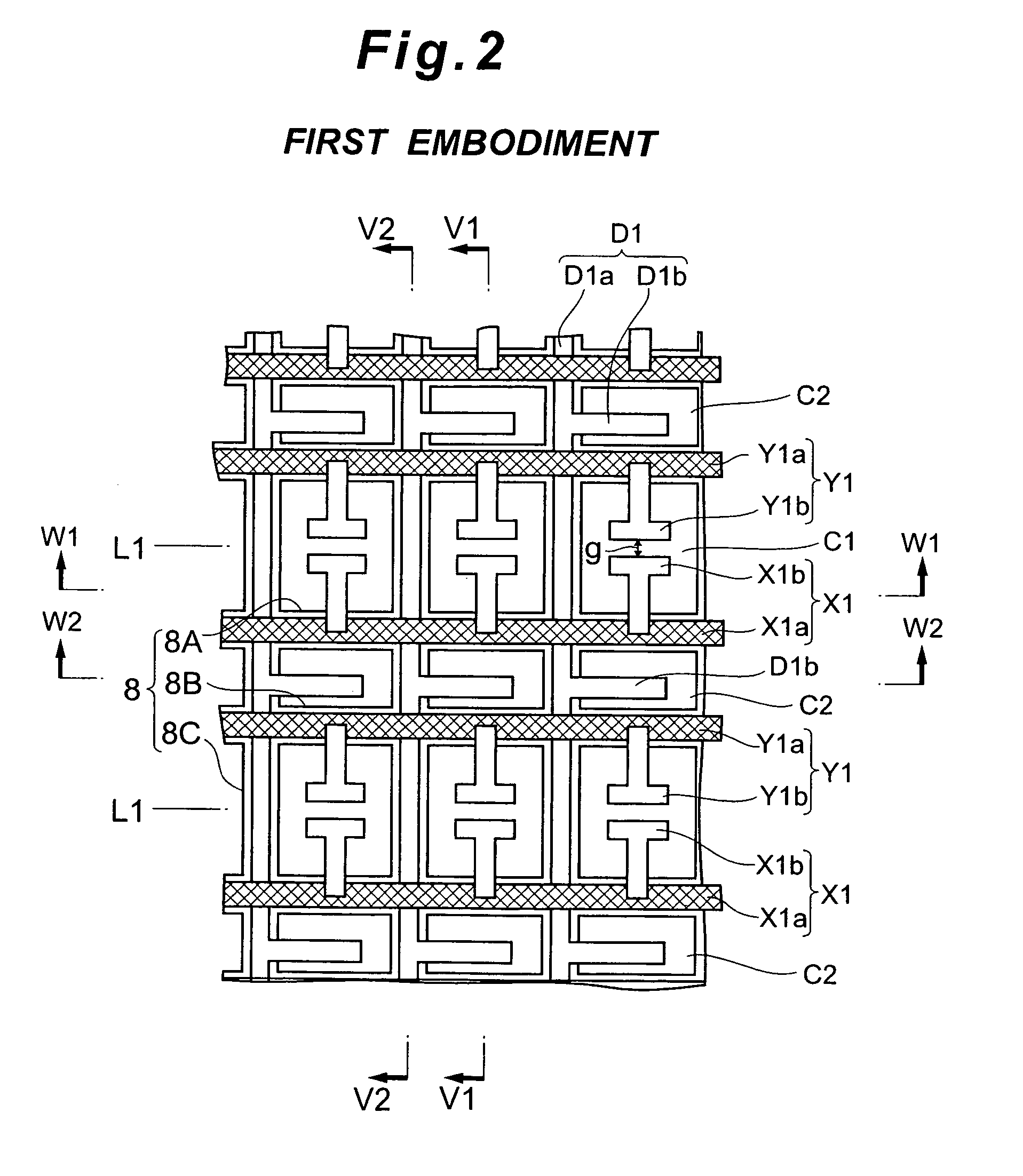Plasma display panel including partition wall member
a plasma display panel and partition wall technology, applied in the direction of gas discharge vessels/containers, gas-filled discharge tubes, electrodes, etc., can solve the problems of increasing costs, affecting the quality of plasma display panels, and requiring compatibility between plasma discharges, so as to reduce manufacturing costs, prevent emissions, and simplify the manufacturing process
- Summary
- Abstract
- Description
- Claims
- Application Information
AI Technical Summary
Benefits of technology
Problems solved by technology
Method used
Image
Examples
first embodiment
[0054]FIG. 2 to FIG. 6 are diagrams illustrating a plasma display panel (hereinafter referred to as “PDP”) according to the present invention: FIG. 2 is a schematic front view of the PDP and FIGS. 3, 4, 5 and 6 are sectional views respectively taken along the V1—V1 line, the V2—V2 line, the W1—W1 line and the W2—W2 line as shown in FIG. 2.
[0055]In FIG. 2 to FIG. 6, a plurality of row electrode pairs (X1, Y1) each extending in the row direction of a front glass substrate 1 (i.e. the right-left direction in FIG. 2) are arranged parallel to each other on the rear-facing face of the front glass substrate 1 serving as the display screen.
[0056]The row electrode X1 is composed of a black- or dark-colored bus electrode X1a formed of a metal film extending in the row direction of the front glass substrate 1, and T-shaped transparent electrodes X1b formed of a transparent conductive film made of ITO or the like. The transparent electrodes X1b are lined up along the bus electrode X1a at regula...
second embodiment
[0093]FIG. 7 to FIG. 11 are diagrams illustrating the PDP according to the present invention: FIG. 7 is a schematic front view of the PDP and FIGS. 8, 9, 10 and 11 are sectional views respectively taken along the V3—V3 line, the V4—V4 line, the W3—W3 line and the W4—W4 line as shown in FIG. 7.
[0094]In FIG. 7 to FIG. 11, a plurality of row electrode pairs (X2, Y2) each extending in the row direction of a front glass substrate 1 (i.e. the right-left direction in FIG. 7) are arranged parallel to each other on the rear-facing face of the front glass substrate 1 serving as the display screen.
[0095]The row electrode X2 is composed of a bus electrode X2a formed of a black- or dark-colored metal film extending in the row direction of the front glass substrate 1, and T-shaped transparent electrodes X2b formed of a transparent conductive film made of ITO or the like. The transparent electrodes X2b are lined up along the bus electrode X2a at regular intervals, and connected to the bus electrod...
third embodiment
[0134]FIG. 12 to FIG. 16 are diagrams illustrating the PDP according to the present invention: FIG. 12 is a schematic front view of the PDP and FIGS. 13, 14, 15 and 16 are sectional views respectively taken along the V5—V5 line, the V6—V6 line, the W5—W5 line and the W6—W6 line as shown in FIG. 12.
[0135]In FIG. 12 to FIG. 16, row electrodes X3 and row electrodes Y3 each extending in the row direction of a front glass substrate 1 (i.e. the right-left direction in FIG. 12) are regularly arranged in alternate positions at required intervals in the column direction on the rear-facing face of the front glass substrate 1 serving as the display screen.
[0136]The row electrode X3 is composed of a bus electrode X3a formed of a black- or dark-colored metal film extending in the row direction of the front glass substrate 1, and transparent electrodes X3b formed of a transparent conductive film made of ITO or the like. The transparent electrodes X3b are lined up along the bus electrode X3a at re...
PUM
 Login to View More
Login to View More Abstract
Description
Claims
Application Information
 Login to View More
Login to View More - R&D
- Intellectual Property
- Life Sciences
- Materials
- Tech Scout
- Unparalleled Data Quality
- Higher Quality Content
- 60% Fewer Hallucinations
Browse by: Latest US Patents, China's latest patents, Technical Efficacy Thesaurus, Application Domain, Technology Topic, Popular Technical Reports.
© 2025 PatSnap. All rights reserved.Legal|Privacy policy|Modern Slavery Act Transparency Statement|Sitemap|About US| Contact US: help@patsnap.com



